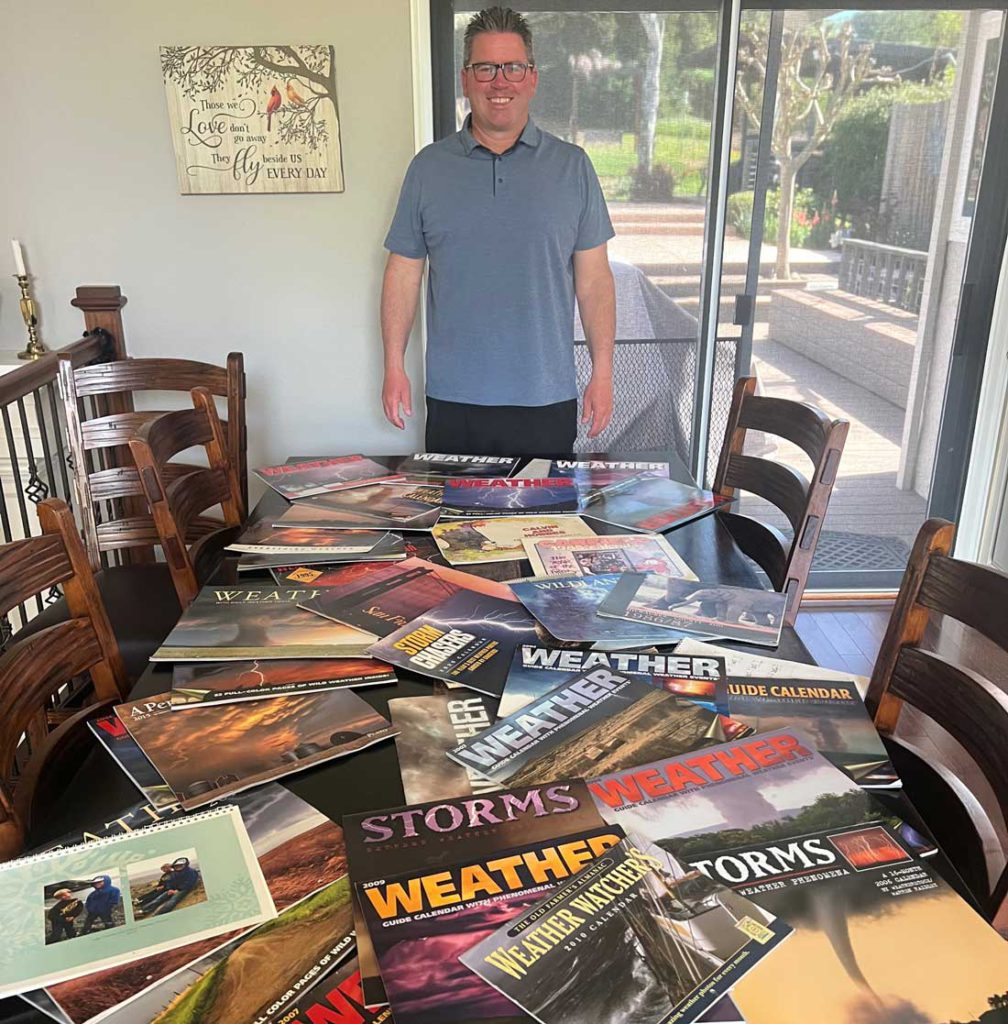
When he was a young boy, Chris Henry experienced a thunder and lightning storm while living in San Jose that he said, “freaked me out and I became obsessed with the weather.”
At age 10, the family moved to Morgan Hill and two years after that in 1983 while in the sixth grade, Henry, now 54, began tracking rainfall amounts from a gauge set up at his parents’ house. Eventually he added high and low temperatures, then in 2016 he started the Morgan Hill Rainfall Facebook group that now has nearly 5,000 followers from throughout the South Valley and beyond.
Although his career goal was to be a meteorologist, life has a way of altering plans.
“That was my career path, really, that was what I was going to do,” he said one afternoon sitting in the backyard of his parents’ (Bruce and Judy) home where he’s kept the gauges to retain consistency of his data. “But I fell in love with being a swim coach and went that route instead.”
He earned a two-year degree at West Valley Community College and being a swim coach didn’t require a four year degree. He swam while a student at Live Oak and loved it. Now he teaches swim lessons to children 9-13 at his parents’ home.
Weather is his hobby and his keen interest. He has kept records continuously from that location and always thought he’d keep them to himself. Sometimes people would ask how much rain fell and he’d tell them. About 2016, Facebook pages were all the rage and he was thinking of starting a rainfall page for the weather.
Then one day, he and his friend and local financial planner Brad Ledwith were having lunch and Ledwith asked him if he ever thought about starting a Facebook page.
So, he started one and made the page private and invited a few weather nerds and Ledwith, whose kids were taught to swim by Henry. The original data he posted was the day’s rainfall, the record for the day dating back to 1983, totals for the month and the year.
Then Ledwith asked why his page is private. Henry told him no one cares about the weather. “Chris, I think you’re wrong,” Ledwith told him. “So I opened it up to the public, Brad shared it and I got 20 to 30 followers and I thought that was pretty cool.”
It was Ledwith who was the trigger, Henry said. But Morgan Hill Weather was taken so he picked Morgan Hill Rainfall since he had all this data going back to 1983 and thought Morgan Hill Rainfall was unique. “I do have accurate rainfall data so it makes more sense and I’m more focused on that and I have every snowfall record too.”
“I told him, Chris this is phenomenal,” said Ledwith.
Summer came and he didn’t post anything like he does now. Then the 2016-17 winter arrived and Morgan Hill saw heavy rains. Some daily records were shattered and the page grew a little bit.
“Then at one point I started writing my insights into my forecast,” he said. “I’d take the official forecast and cater it to our little microclimate here. I’d never be arrogant and go against the models. You have to look at the models and favor one or the other, so I started writing my insights and reporting records.”
Then the big floods came in January 2017 and he wrote that there could be a big flood the next day with up to 8 inches of rain. When it hit, that’s when a levee north of Morgan Hill broke and flooded U.S. 101.
“I was one of the last cars to get through,” he said. “I took a video of it and that went viral.”
That video got more than 800,000 shares and a few days later he checked and got several hundred more followers and he was kind of freaked out, he said.
“I don’t have anxiety at all but I was having full blown anxiety like is there an expectation of me,” he recalled. “What if I’m wrong now, who are these people? Every fall and winter it grew and during the big winters it grew even faster. Then it hit 2,000 then 3,000 and now it’s approaching 5,000. Some of my friends in Almaden Valley followed my page not knowing it was me.”
When he looked at who was following the page he saw there were several meteorologists.

One of those was KTVU Channel 2 morning meteorologist Steve Paulson, who Henry talks to every day.
Everybody has a microclimate where they live in the Bay Area and they’re all unique, Paulson said, and Henry has discovered it’s not easy to make a forecast on a daily basis.
“The northern end of the valley versus the southern, the western edge versus the eastern. They all can have different highs, lows and rainfall,” Paulson wrote in an email.
“Wind shifts, temperatures, rainfall projections, it’s not easy but Chris has a good handle on the idiosyncrasies which can make or change a forecast,” Paulson added. “He’s helped me a lot. He posts solid information. A southwest or southeast wind direction can make a huge difference on the forecast. Chris knows that better than me for Morgan Hill and the Valley. Chris knows Santa Clara Valley better than anyone I’ve met.”
Henry said he has access to most of the same forecast models the professionals use, but he focuses mainly on South Valley. He learned everything about the weather by studying models and other teaching tools online.
As far as the region’s microclimates, he learned just from living here.
“When I went to an open house at the National Weather Service in 1995, forecaster Jan Null said no one knows the microclimate better than the people who live there. For example, San Jose and Hollister have the same dryness. In Morgan Hill, two locales a quarter mile away, your air conditioning bill could be significantly different due to the microclimates even in Morgan Hill.”
While talking about the weather, Henry can recite records off the top of his head.
He recalled the big El Nino in 1997 and 1998 with more of a south flow where Morgan Hill got 5 inches less rain than San Francisco and 18 inches less than Santa Cruz. In 2016 and 2017 Morgan Hill received 51 inches, Santa Cruz 44 or 45.
“That was really amazing,” he said. “Without the mountains to our west, forecasts would be so easy,” he said. “That’s why I wait until three or four days before the high resolution models come in and the accuracy goes up.”
On the state level, one thing the models predicted even back in 1990 were drier droughts and wetter winters and that is exactly what is happening, he said.
“Amazingly, in an 8-year period ending two years ago, California had two of the driest and two of the wettest seasons on record,” he said.
Henry said this weekend will be nice with highs about 70 degrees with lows in the mid-40s. As far as getting more rain before summer arrives, Henry said we may see some the last week of April and into early May, which won’t amount to much this time of year.
Regardless, his followers will continue to read his posts. Summer is coming.
“Local weather is fascinating and he made it so simple for all of us to understand,” Ledwith said. “When he created the group and it became public it created a life of its own.”












